This here is the second part of our Oculus Quest game reviews, this time a mixture of brand new release and launch titles! Check out the first 10 reviews in part one here: https://www.opiumpulses.com/article/306/10-oculus-quest-new-release-reviews-p1
Let’s start in alphabetical order, simply ‘cause it's prettier…
Bonfire
The developers of Bonfire are known for their VR-based interactive short stories, having worked on Invasion!, Asteroids! and Crow: The Legend. Bonfire is no different, in that it is a short animated movie, in full VR with direct but linear interactivity peppered throughout. The story is based around your experience after crash landing on an alien planet, a planet that really is not what it seems at first sight.
There’s not much choice in what or how you interact with the objects surrounding your landing sight and no option to move or explore the planet besides what presents itself to you. The experience is cute and immersive and genuinely humorous in some areas (immaturely flat in others). For those who just want to be immersed in and experience an exciting moment in time without having to think too hard, experiences like Bonfire really deliver. But there’s a glaring downside to these types of titles…
The length… it’s just far, far, far too short. At an absolute push, this title won’t last you much longer than half an hour, and with the lack of actual choices to be made, the replayability potential for the same person is next to none. Given that blockbuster DVDs offer up to 3 hours of content for just a few quid more, it starts to make the £8 you’d spend on Bonfire just a little painful, even if you adored the time spent in it. If the same length was applied to your time in space before you land, Bonfire could have avoided losing points due to its upsettingly short length. We’re sad to say it gets only a…
6/10
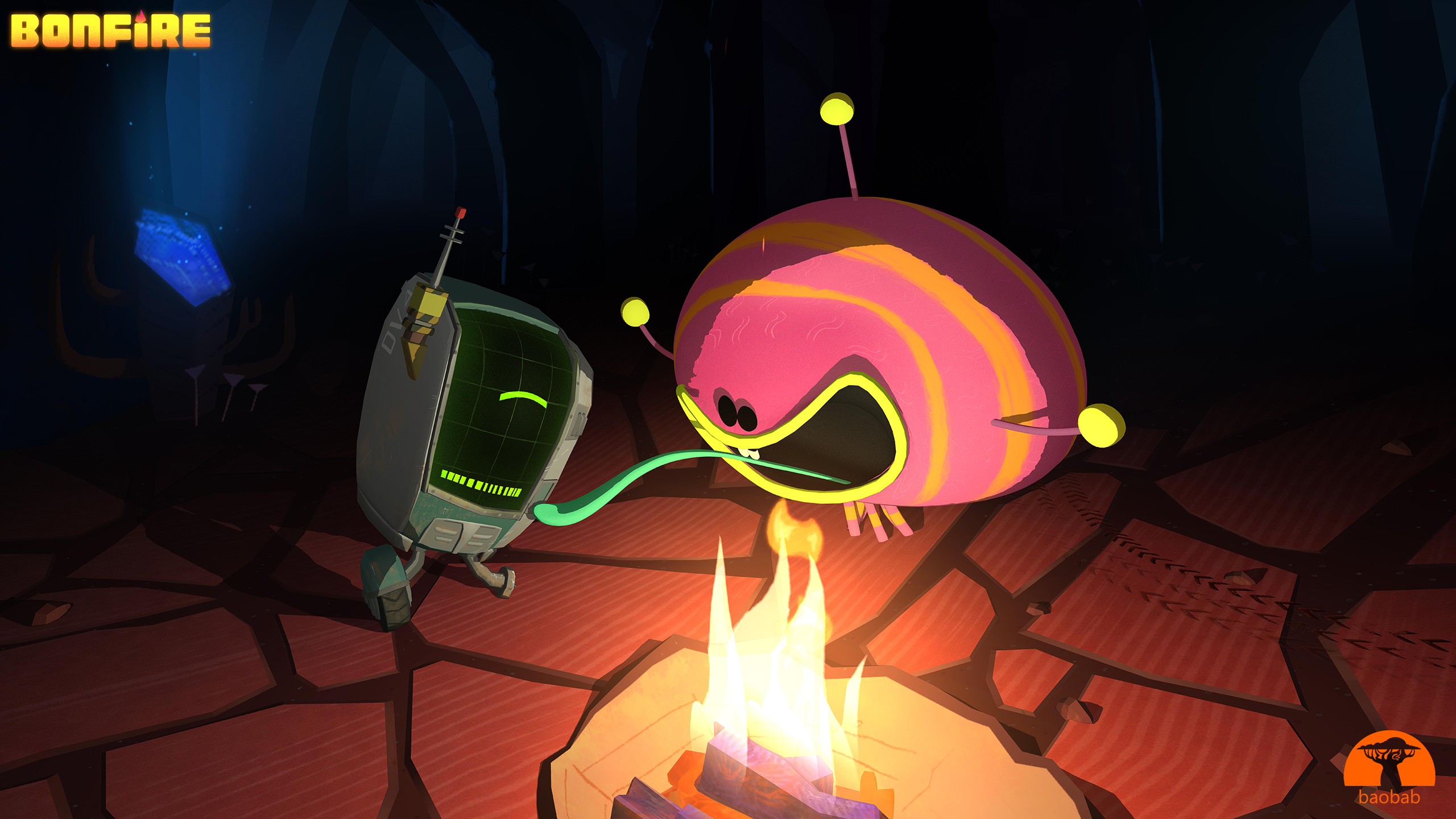
BoxVR (Now known as FitXR)
Fitness games are in a weird space with VR, on one hand, they seem to make little sense, being comfortable while working out is important for persistence and VR headsets aren’t known for their luxurious comfort, but on the other hand, enjoyment is of equal importance to help keep you engaged. BoxVR is probably not what you’d expect at first, unlike games such as Creed it is not purely a boxing game, in fact, the only real connection it has with Boxing as a sport is that you see virtual gloves where your controllers should be and you punch targets to a rhythm.
BoxVR is actually a lot closer to titles like BeatSaber than any games directly related to sports. You jab and weave to various collective music tracks of all genres, many of the moves mapped by fitness professionals. And as you improve and perform faster songs it really starts to feel great. The sense of a real work out is very real, even if just after 30 minutes of gameplay. There is a decent amount of content and a very comprehensive selection of music to box to which really helps add to its replayability – our only wish for content is possibly more arenas to play in, two are very similar and one is pretty generic.
One struggle we had with BoxVR early on is that it seemed many of our punches were not being registered, particularly the swings and uppercuts, you can have honed rhythm and excellent timing and yet still seem to miss them almost every time, and the tutorial does not help teach you how to hit the markers the way the game wants you to. The only thing we can say on this is.. persevere, eventually something clicks and after some trial and error you eventually learn how to hit each target precisely, if not you may need to search some guides online as we promise the game is not broken. Besides this we’re having more and more fun every day and think anyone who enjoys rhythm games or wants a platform that will help them stay fit or even lose weight, you could make much worse choices than BoxVR. With some extra polish and customisation choices, this would get a perfect score, for now, it gets a solid…
8/10
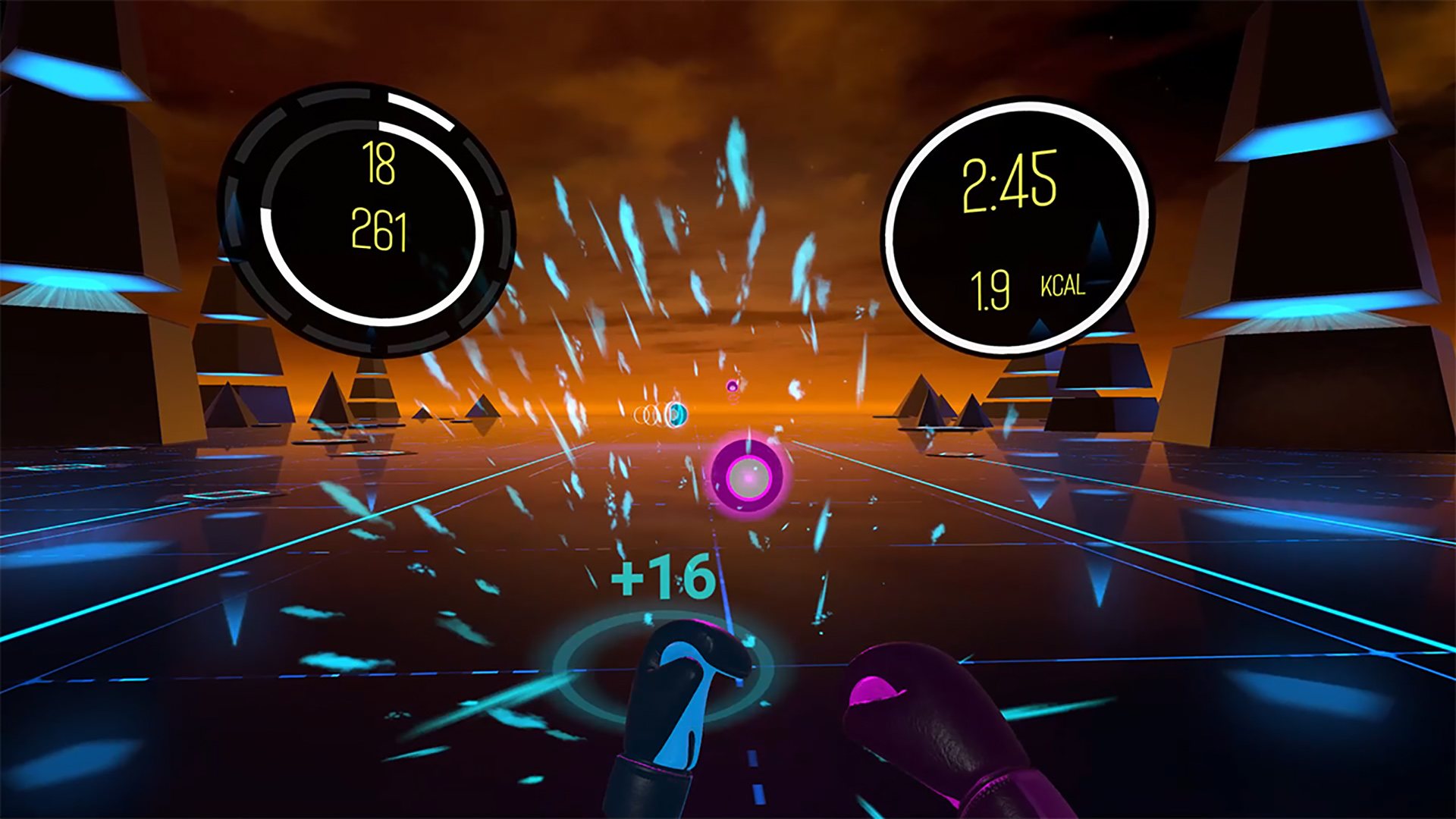
Fujii
Looking like the love-child of James Cameron's Avatar and Charlie and The Chocolate Factory, the world of Fujii is a colourful and vivid wonderland of plants, puzzles and pets! At first, I really wasn’t feeling Fujii, it starts rather slow and the objective isn’t made very clear to you. But the game grows on you pretty quickly (no pun intended) and you start to get really invested in exploring the land and opening up new areas. The basic challenge seems to be releasing light into dark areas to allow further exploration, this can be through interaction with the plant life, petting little critters or solving satisfying puzzles.
One thing we liked that you rarely see in VR, is the way the game emulates your arms, and fairly accurately too (which shows it can be done!). You appear to be some sort of plant matter in humanoid form and can pump your arms up with water to bloom flowers etc. Another thing that is rare is that the game does very little hand-holding, but so far I’ve not become frustrated because I can’t work out what to do, once you open the large area the excitement you get to solve all the little puzzles and open the area up is real. There’s no list of objectives, minimaps or HUD arrows pointing you in the right direction, your only job is to explore – and that’s a refreshing position to be in.
As for negatives (and I don’t mention this for most titles but Fujii really suffers because of it), our biggest gripe is that the game has no options for seated mode, in fact besides language it has no options at all, including no way to back out to the menu once you’ve started the game. So if you’re disabled or like me have back pains after standing for too long, Fujii suddenly becomes rather frustrating to play, as once you sit down you’re just one foot or so from the floor and tall plants etc are hard to reach. Many games solve this by just having a togglable seated mode that artificially increases your height in-game, it's not hard and there’s no reason for VR devs to loose out on the custom of seated customers by not including it. With this fixed, we think Fujii could hit a higher rating, but with those issues, we’re giving it a…
7/10

Nature Treks VR
Virtual Reality doesn’t always have to be intense and fast-paced, it can also provide calming and relaxing experiences that allow you to forget your troubles and just enjoy a moment. Nature Treks give you around ten different locations to explore from luscious meadows, winter forests, deep ocean and even outer space - all offering their own flavour of beauty and tranquillity.
You can explore the locations at your own pace and even have options to influence the world around you, grow a plant, spawn a school of fish or big bang planets, suns and black holes into existence (naturally the nerd in me enjoyed the space simulation the most). If you have a stressful job or home life and need help winding down away from other quite frankly, annoying humans – then you could do much worse than spend your time in Nature Treks.
The gamer in me was left longing for more interactivity, especially in the ocean and space areas. Nature Treks will relax and soothe you, guaranteed, but it isn’t the best sandbox, something with just a little extra interactive content it could easily be! However, this isn’t what Nature Treks claims to do, just something we think would improve what it is. We believe with more to do in the areas we have, NT could easily snag a point higher, but for now, it sits respectably at a…
7/10
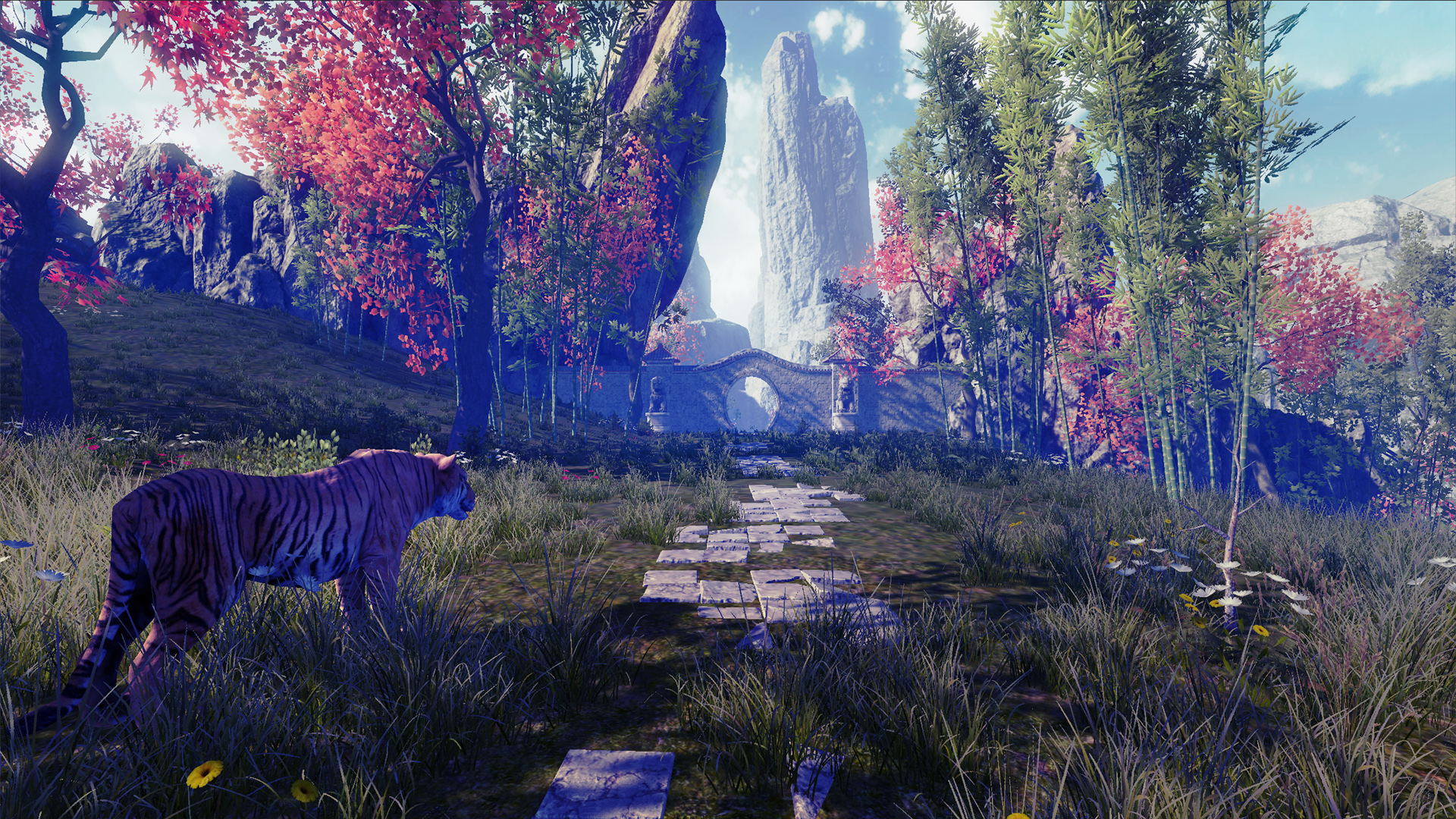
Racket Fury: Table Tennis VR
What might appear to be a pretty trivial game at start, quickly begins to genuinely impress the more you play. Racket Fury is a table tennis/ping pong game that emulates the table and physics of the ball pretty brilliantly and the visuals are very crisp and detailed. One thing I usually hate in video games are Robots that act as your competitive AI, there’s very rarely any personality or charm that comes with them – but in RF, the robots are chirpy and emotive with fluid and cheeky animations.
The game has single-player tutorials, training and tournament modes as well as online multiplayer (that even allows you to choose the server’s region). Our gripe with single player is that for people who suck just as much at virtual table tennis as they do at physical table tennis, the difficulty curve seems rather harsh, the AI rarely misses even when you’re proud of the shots you send their way. We imagine what is required is a fair bit of practice (as with any sport), which is fair enough, but I have a feeling some people (children too, for example), would struggle to break through that initial skill wall.
The multiplayer is active at time of writing, with a handful of people playing in each region, which for a VR game focused on a single experience is actually pretty decent. I think this title’s biggest audience is for those who appreciate or enjoy table tennis as a sport, as Racket Fury emulates that experience pretty flawlessly. With everything positive that it nails and lack of a [much] easier game difficulty considered, Racket Fury gets a fair…
8/10
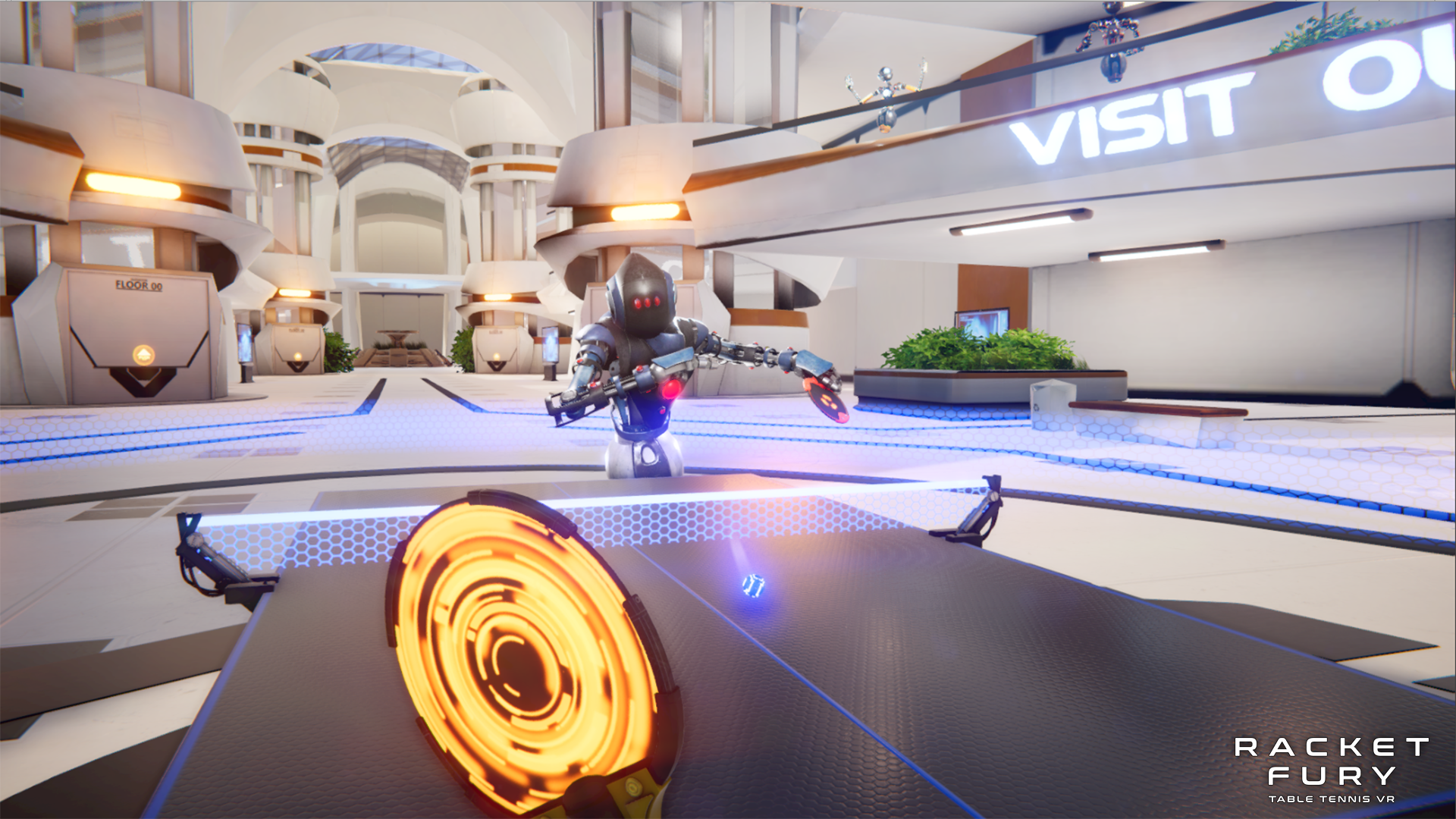
Rush
While an odd choice for a VR experience, Rush certainly is a fun one. The idea is that you dive and subsequently fall from planes, skyscrapers and mountain tops, with nothing but your squirrel-like wingsuit to help you glide through the checkpoints scattered above the forests and valleys below. Falling from a height in most games usually results in a little sickness, but Rush seems to avoid this side-effect, to the point that it actually feels pretty comfortable, despite what a certain part of your brain believes is happening.
The game, unlike any others we have played, offers 8 different control schemes, as well as a standing and sitting option – all of these will suit different people for different reasons and really helps you identify the most comfortable and enjoyable method of play to match your preferences. Each control option can be quickly tested in the tutorial and you can switch between sitting and standing before each race in the settings. The game looks great and seems to have a decent amount of content to keep you occupied, something a lot of specialised VR titles seem to lack.
The multiplayer seems busy for now and performs without a hitch. You begin suited up in the plane with a bunch of physics drenched toys to play around with together (basketballs, stacked cans, nerf guns etc) which keeps you entertained until more players join and the race starts, which is a nice quality of life addition for the future when multiplayer games might have longer lengths between them. Our main and only disappointment is that Rush seems to be somewhat of a one-trick-pony, the game is what it is and there isn’t much else offered. We’re not too sure how long the gameplay of Rush could keep you interested and for that it does lose a few points, but what we played we had little to complain about and for that, it at the very least deserves a…
7/10
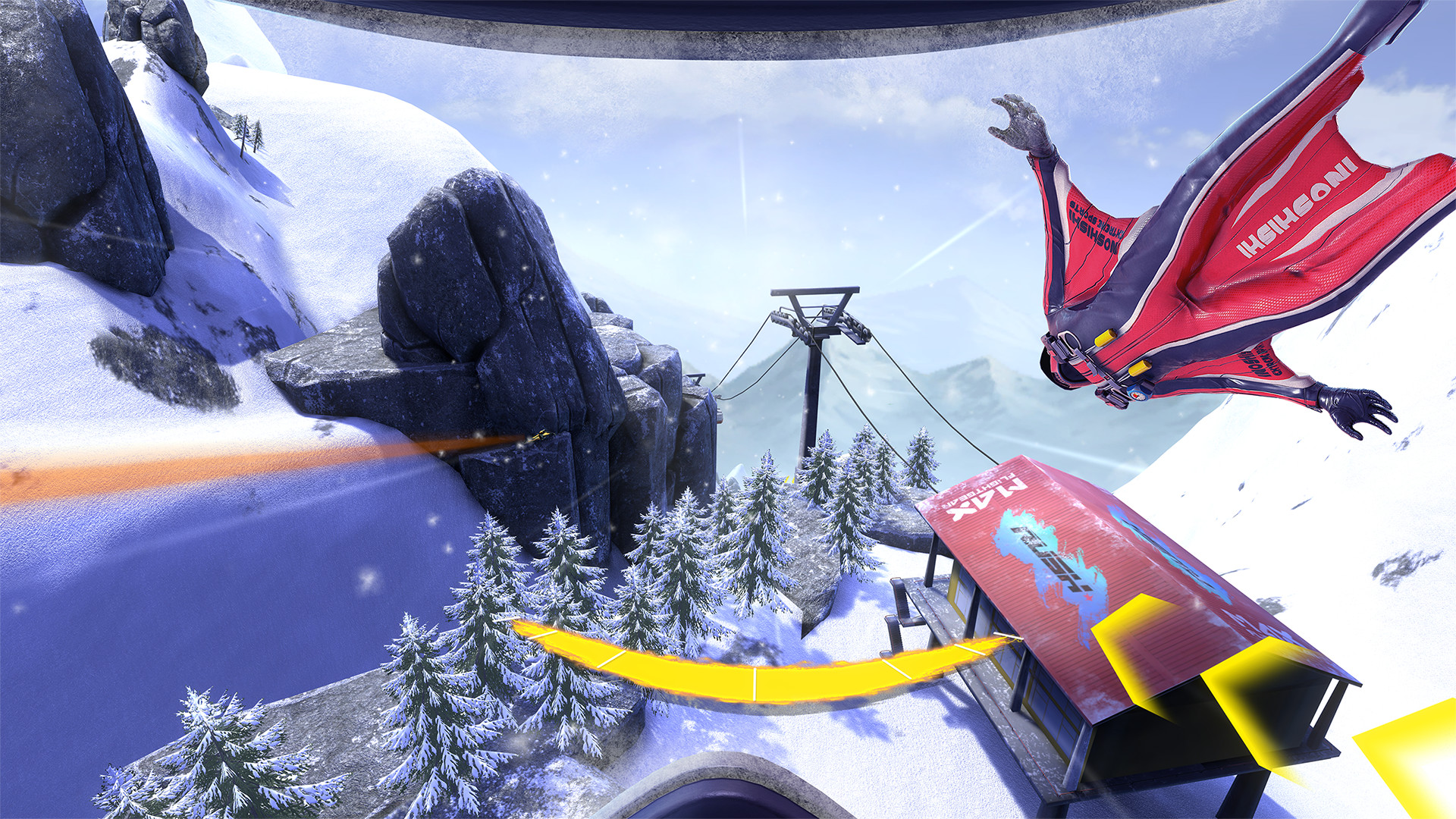
Sairento VR: Untethered
This must be the most impressively agile first-person VR game we have ever had the joy of playing. The devs quite clearly set out with trying to make you feel like a genuinely skilled ninja of sorts, and they don’t fall too short of perfection there. Giving you the freedom to jump incredible heights, crouch slide, wall run, double jump and even slow downtime. Combined with combo choices of various guns and full-length katanas that can slice your enemies clean in half, you feel like the final boss 30 seconds into the first mission!
There’s seemingly lots of content in Sairento, but of what we tried we absolutely adored, the main bulk of the content seems to be centred around an outnumbered but rarely outgunned horde fight between yourself and increasingly difficult enemies, that you will learn to eliminate in constantly evolving strategies and manoeuvres. We imagine the majority of your time will be spent high up in the air jumping from platform to platform aiming a headshot at one enemy while you simultaneously raising your sword to slice the limbs off another… like we said, crazy stuff. For a game as fast-paced and all over the place as Sairento is, we expected quite a lot of motion sickness to come with it, and while it does have slight moments of stomach jigs, for the most part, we were comfortable with the movement, however, new VR users may wish to ease themselves in with less intense games first.
Sairento’s downsides are only that swordplay can sometimes be a little janky and the controls don’t yet seem perfect – for instance, teleporting uses forward direction of the analogue stick and snap-looking left or right uses left/right movement of the stick, meaning not only is it hard to go backwards if you mess up a jump, but sometimes you’d teleport without even meaning to. We’re sure a combination of post-release polish and regular player practise will evaporate these frustrations in time and outside of that, you have a fantastic and well-priced must have on yours hands, and with co-op rumoured to be on the horizon, it’s only going to get better! Right now it easily lands an…
8/10
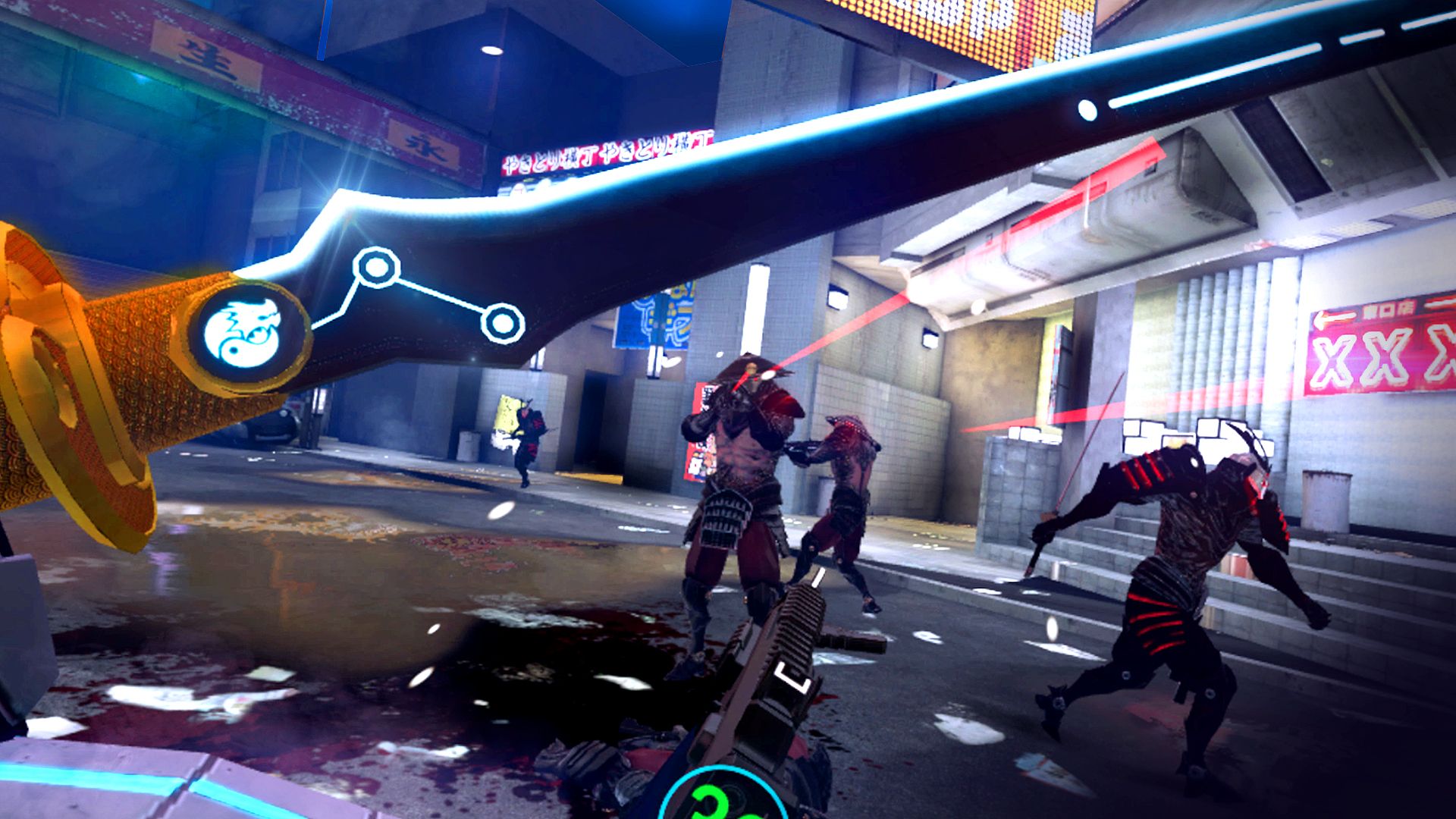
Sports Scramble
This is just a weird one – intentionally so but weird none-the-less. Sports Scramble is almost like a Kinect/Wii Sports VR title but with a pretty significant twist. Balls, rackets and bats from ANY sport can suddenly be chucked into the wrong type of game at a moment’s notice – so, for example, you could be playing tennis but with baseball bats and a beach ball. Bowling goes even further, giving you weird item mutators that completely change up the gameplay (our favourite so far of the three sports), such as pineapples or a huge wheel of cheese (with borderline realistic physics) as a bowling ball.
The game currently has three sports: Tennis, Baseball and Bowling – all of which have their own associated tutorials and single-player challenge modes – meaning there’s a fair bit of single or pass and play content for your buck. All included sports are also fully playable in online multiplayer; however, we didn’t get to play this as we couldn’t find a match so soon after launch. We did find ourselves wondering whether the sports mashup idea was even a decent one, rather than making matches harder or easier it didn’t change much variety in the game modes or playstyle and there is the worry that the novelty will soon wear off – we think maybe an additional (not ball focused) sport and some crazier scrambled items would really flesh out the comedy and randomness it offers.
Sports Scramble is currently the only family sports pack available on the Oculus Quest and does a decent job of trying something new. It’s fun, well-polished and charmingly colourful – but when considered against its lack of varied sports, rather quiet multiplayer and just barely avoiding meeting its full potential. SS seems like the sort of game that could be perfect for one person or a wet flannel to another, we’re in-between however and think with some future improvements, it could easily demand more than our score of…
7/10
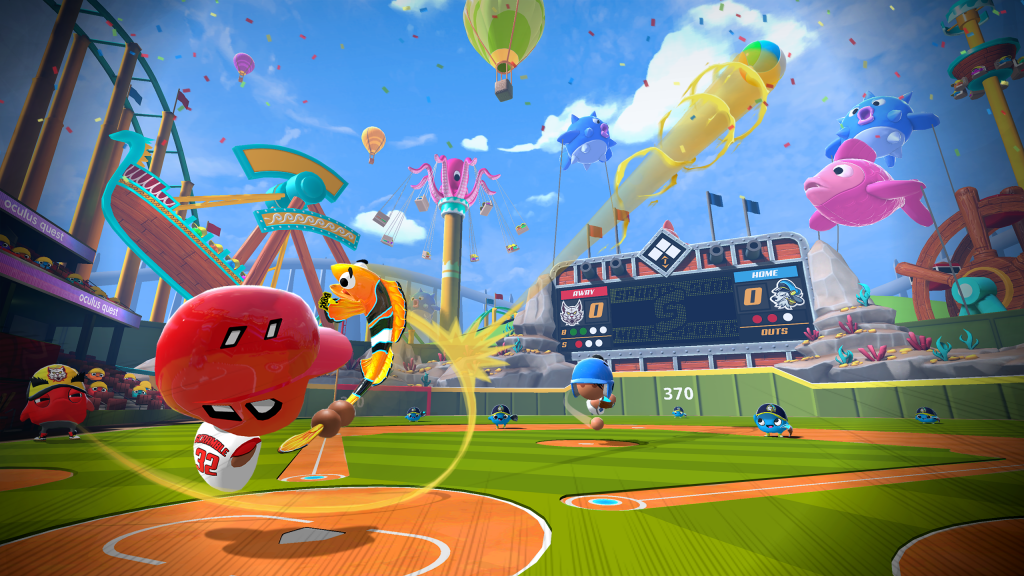
Ultrawings
We haven’t played too many flight simulators in VR but Ultrawings is one of the veterans of the genre on the platform. Releasing in early 2017 for the Oculus Rift and later that year for the Gear and Go headsets. Naturally, the developers of Ultrawings wanted to support the Quest headset and managed to have it finished it time for launch. While not the most hardcore of flight sims, Ultrawings takes a more laid back and almost toybox-like approach, with colourful and simple graphics. The aim is to learn how to fly and then complete various airborne challenges, improving your skills and upgrading your aircraft as you go.
It seems like a lot of progression and content fleshes the game out but it’s mostly focused on flying around and performing certain manoeuvres and competing in races. Ultrawings is not an arcade pick-up and play kind of title, it takes time to learn how the planes operate and hone your skills. One thing we appreciated was the various options available to help users shoo away the nausea/motion sickness of intense experience VR games, allowing you to slowly reveal more of your field of view by removing panels from the plane to ease yourself towards a complete 360 view. We genuinely believe options like this help new VR users get used to movement in VR and enjoy a broader selection of experiences. Kudos to the devs for helping people adapt.
Sadly no game is perfect and Ultrawings only lets down in a single area: The controls. My god, they’re frustrating. You’re required to push nobs, flick switches and pull levers before the plane can even take off and it's an absolute pain in the side to get right, the controls are so unresponsive that you’re left frustrated when you’re trying to have fun, and what’s worse is that you’re expected to do some of this when you decline for a landing too – the worst possible time to be under pressure! Right now it seems this is just an issue affecting the Quest version of the game and will probably be ironed out in future patches, but right now its unnecessary hassle. Our wish would be that the devs add an ‘arcade’ mode that leaves all that finicky stuff out and just allows instant flight and landing, which would also help kids get into the game off the bat. We’ll keep checking back in with Ultrawings and report if things change, but this issue is too big to pretend it doesn’t exist…
6/10
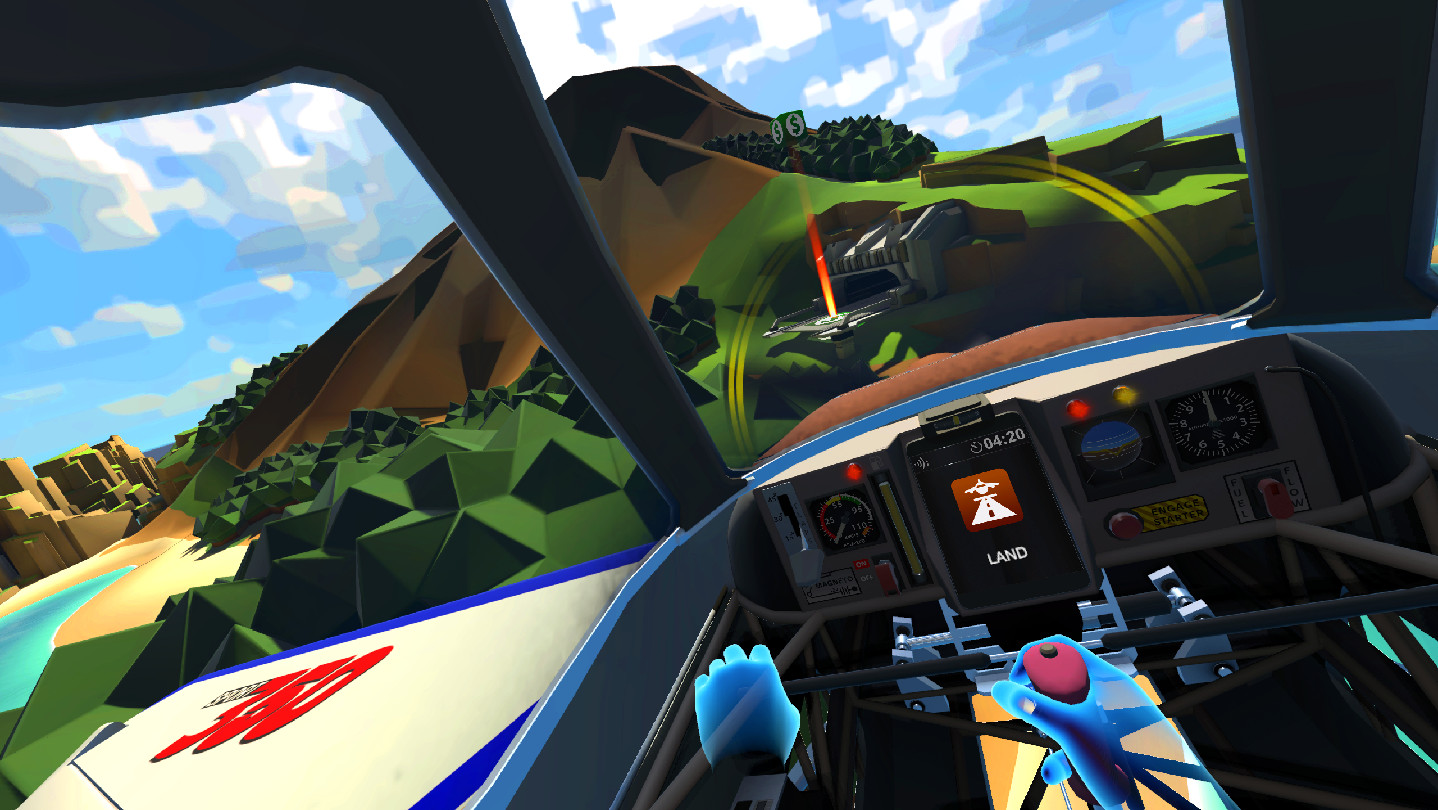
Wander
What can I say about Wander that doesn’t quickly show off how much I adore it? The simple way to explain it is a VR version of google street view, but that doesn’t do it justice at all. Yes – it uses google maps data and images, but what it does with this is just magical! Along with what seems like user-submitted content from boats, vehicles and from long-distance treks, you can search and go almost anywhere around the globe and view it in all directions and for certain locations can even roll back time to see how things were 5-10 years ago. Wikipedia integration means you can learn about your destinations as you travel and voice recognition means even those with certain physical disabilities can explore – this is much a much bigger deal than you might think, many disabled people cannot travel, especially not to such exotic locations and Wander makes this virtually possible for them.
Already sounds great right? Well, it gets better! Wander allows for people with multiple headsets to travel the world together, even if they’re on opposite sides of the planet themselves! Connecting to and following a friend on their journey is seamless and even works with Oculus Parties. It would also appear that full cross-platform play between Samsung Gear, Oculus Go, Oculus Quest and Oculus Rift headsets is possible (we tested between the Quest and Go), that’s an amazing feat and something my long-distance fiancée and I massively appreciate.
I struggle to come up with many issues with Wander, it can be buggy at times and does crash from time to time if it fails to load a certain area correctly, the pointer on the Quest is also very glitchy and it seems completely random whether it appears or not, but shaking the controller lightly often brings it back. None of this kills the overall enjoyment of the game and what matters most works well. Wander provides a beautiful experience with masses of replayability and helps keep you connected with your distant loved ones. Wander is one of the easiest titles for us to score so far...
9/10
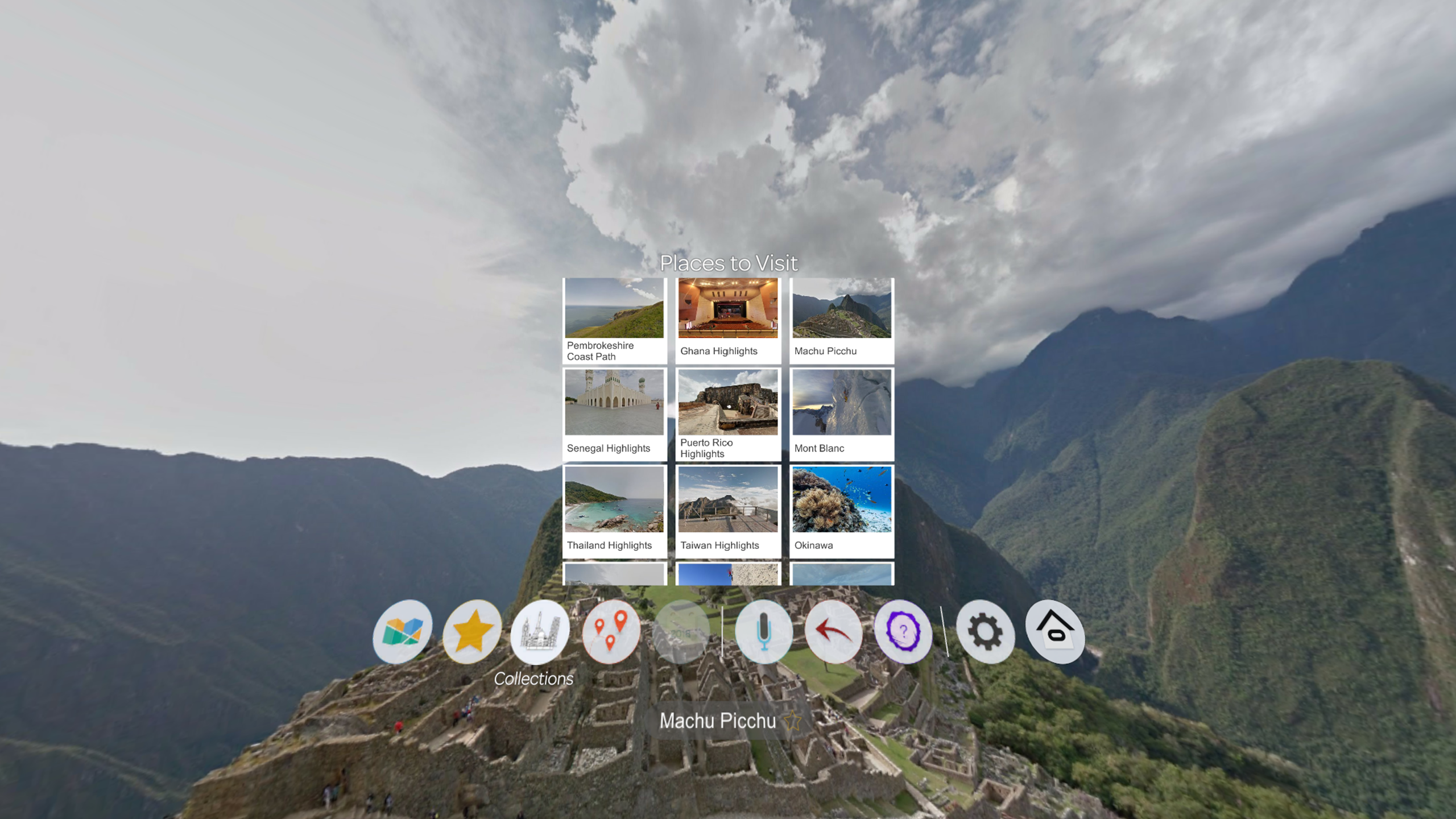
Do you have an Oculus Quest? Which games are you enjoying the most so far? Has it met, failed to meet or exceeded your expectations?


